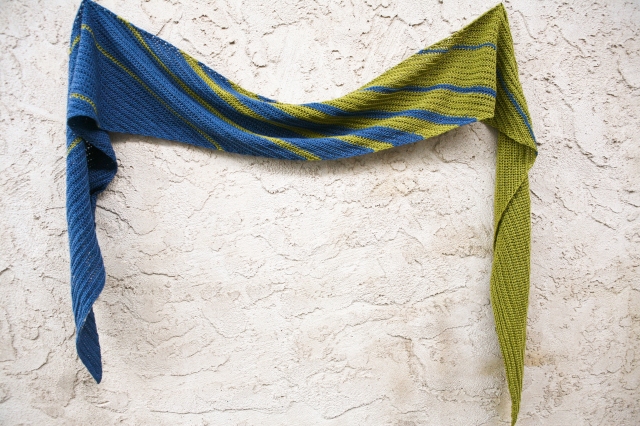This scarf is totally biased. That’s not to say that it’s prejudiced, but that it was worked in the diagonal direction of the cloth.
My project was made from Julie Blagojevich’s free pattern Fibonacci’s Biased using Knit Picks Curio. The number of rows in each stripe is according to the numbers of the Fibonacci sequence up to 34. In other words, if you start at the blue side of the scarf and work your way right, the sequence of the number of yellow rows is 1, 1, 2, 3, 5, 8, 13, 21, 34. The sequence of the blue stripes are the same, but in the opposite direction. The effect is a rotationally symmetric scarf with few color changes at the edges and frequent color changes in the center. As I frequently tell my friends, math is beautiful.
If my geekiness hasn’t scared you away yet, here’s a random fun fact: my project was the 42nd one of this pattern to be posted on Ravelry! And as the computer Deep Thought so famously stated in The Hitchhiker’s Guide to the Galaxy, 42 is the answer to the ultimate question of life, the universe, and everything.


Pingback: WIP It Good Recap | Knot Theorist
This is a lovely scarf and I really like the mathematics that you included. In college, I took a class dealing with the mathematics of art and it was incredibly fascinating- it also dealt with the Fibonacci sequence.
http://www.divinedebris.com
LikeLike
Thank you! I love the mathematics of art – almost as much as I like the art of mathematics. 🙂
LikeLike
Pingback: WIP It Good Progress |
wait is it a scarf … or a towel? 😀
LikeLiked by 1 person
It’s a scarf… But it is pretty large!
LikeLiked by 1 person
Then is may be just about the most massively useful thing any interstellar Hitchhiker can carry….
LikeLiked by 1 person
Wow, what a compliment! 🙂 Thanks!
LikeLike
Reblogged this on nebusresearch and commented:
Here is a neat bit of crochet work with a bunch of nice recreational-mathematics properties. The first is that the distance between yellow rows, or between blue rows, represents the start of the Fibonacci sequence of numbers. I’m not sure if the Fibonacci sequence is the most famous sequence of whole numbers but it’s certainly among the most famous, and it’s got interesting properties and historical context.
The second recreational-mathematics property is that the pattern is rotationally symmetric. Rotate it 180 degrees and you get back the original pattern, albeit with blue and yellow swapped. You can form a group out of the ways that it’s possible to rotate an object and get back something that looks like the original. Symmetry groups can be things of simple aesthetic beauty, describing scarf patterns and ways to tile floors and the like. They can also describe things of deep physical significance. Much of the ability of quantum chromodynamics to describe nuclear physics comes from these symmetry groups.
The logo at top of the page is of a trefoil knot, which I’d mentioned a couple weeks back. A trefoil knot isn’t perfectly described by its silhouette. Where the lines intersect you have to imagine the string (or whatever makes up the knot) passing twice, once above and once below itself. If you do that crossing-over and crossing-under consistently you get the trefoil knot, the simplest loop that isn’t an unknot, that can’t be shaken loose into a simple circle.
LikeLiked by 1 person
It’s nice to meet another blogger who loves mathematics! Thank you for the reblog!
LikeLike